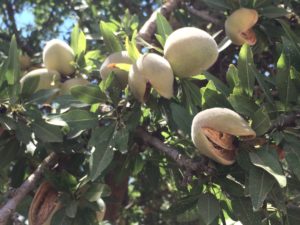
Hull-split often occurs around the end of June though the first week of July within the San Joaquin Valley. The start and duration of hull-split is influenced by the variety, weather, and tree stress. As many are aware, the variety has the strongest influence on hull split initiation and progression, but this article will focus on the influence of weather and tree stress.
Most people believe the weather experienced in mid-June strongly influences the start of hull-split. Research has indicated, however, that this is not true. Work by Ted DeJong (UC Davis Plant Sciences), has found that the beginning of hull-split (which is indicated as 1% hull split) can be predicted by weather conditions experienced during the first 90 days after bloom. Cooler conditions experienced during this time will lead to a later hull-split, while warmer conditions result in an earlier split. Temperatures in the latter half of the spring and early summer have a minimal influence on nut progression, regardless of being warmer or cooler than normal. The model can be found at http://fruitsandnuts.ucdavis.edu/Weather_Services/almond_hullsplit_prediction/ and can be applied using localized CIMIS data.
There is some evidence to support that tree stress and nutrient status influences the duration of hull-split. Stress in June decreases water content within the hulls, which means a faster drying time when they begin to split (think of hull-split progression like a bell-shape curve – stress in June shortens the x axis). This is often related to high heat experienced in June, which leads to tree stress due to inability to properly manage the irrigation or the application of regulated deficit irrigation (RDI). Nitrogen status of the tree also influences the rate of split, in which trees having a higher nitrogen content have a longer duration of hull split.
Often vigorous orchards are grown with minimal stress and higher rates of nitrogen. This leads to an uneven ripening of the nuts within the tree. In some observed cases, nuts on the top part of the tree split 2-3 weeks before the nuts in the bottom half of the tree, which delays harvest and increases the risk of insect and diseases infestation. Implementing good practices such as RDI and proper nitrogen management can reduce the duration of hull-split, leading to an easier shake and harvest.


Mahesh Karoshi
June 7, 2020I am an independent almond grower. I took my almonds to my native country India and trying to sell their. Customers thier are asking they want almonds that are big in size, reddish in color and no wrinkles. I asked my CPA, how to produce these almonds. He told me, we can remove the wrinkles on almonds by not cutting water after hull split. To produce big almonds, you need to be supply right nutrients(nutrient numbers). To produce reddish almonds, he does no kow what to do.
Last year, I did cut lot of water after hull split, to make sure the hull split happens. My almonds had heavy wrinkles. Can some one suggest me how to reduce wrinkles on almonds and also how to produce reddish color almonds.
David Doll
June 19, 2020Dear Mahesh,
Those are tough questions. The wrinkles are most likely due to tree stress during the final phases of kernel fill (e.g. June-August). It is important to keep the tree with low to moderate levels of stress during this period to reduce kernel shrivel. This includes irrigation applications that match the tree’s demand.
As far as the color, this is a component that we cant control. Kernel coloring is tied to the variety and weather conditions. Unfortunately, Independence typically is paler in color than many other varieties. As such, you may not be able to achieve the darker color that you want consistently.
David
The Harvest Is Coming! | Maisie Jane's
July 24, 2020[…] developing and dry. Specifically, for all you nut nerds (we resemble that remark): according to The Almond Doctor, whether this happens in June or July depends on nut variety, available nutrients, “tree […]